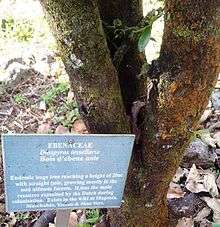Diospyros tessellaria
| Diospyros tessellaria | |
|---|---|
 | |
| Foliage of Mauritian ebony - Monvert Nature Park | |
| Scientific classification | |
| Kingdom: | Plantae |
| Clade: | Angiosperms |
| Clade: | Eudicots |
| Clade: | Asterids |
| Order: | Ericales |
| Family: | Ebenaceae |
| Genus: | Diospyros |
| Species: | D. tessellaria |
| Binomial name | |
| Diospyros tessellaria Poir. | |
Diospyros tessellaria (black ebony, bois d'ebene noir or Mauritian ebony) is a species of tree in the family Ebenaceae.
The tree is one of several ebony species endemic to the island of Mauritius in the western Indian Ocean, and was once the most common, widespread ebony species of that island.
Description


The massive, slow-growing, evergreen tree can reach up to 20 metres (66 ft) in height. The thick leaves have a dark green surface and a slightly paler underside. A distinctive feature is that the leaf margins and veins are mildly translucent, when held up to the light.
They produce small, white, fragrant flowers and fleshy fruits.[2]
History
Like other species of ebony trees, Mauritian ebony trees yield a dark black ebony wood. In its natural habitat, it was a massive canopy tree - common in the dry and upland wet forests of the island.
Exploitation by the Dutch
Vice-Admiral Wybrandt van Warwijck landed on Mauritius on September 17, 1598, thus beginning Dutch involvement with the island. In 1638, settlers from the Dutch East India Company (VOC) attempted to colonize the island and set up an organized ebony business to sell the rare black wood. However, due to issues with cyclones destroying the settlement, rats destroying crops, settlers illegally trading with English ships, and slaves revolting commonly, the Dutch left the island in 1710.[3]
Ebony as a British Import
After the French settled Mauritius in 1721, the British took over the island and Port Louis in 1810. Not only was Mauritius used as a stopping point for ships traveling to British India and other parts of Asia, but now it was also used as a major exporter of goods back to London. While the most popular good from Mauritius was sugar by far, the British did harvest a large portion of the ebony forests. The wood was presumably used for carving and decor in London.
Related species
This species is one of eleven surviving species of Ebony tree which naturally occur on Mauritius - all of them endemic.
- Diospyros tessellaria - the most famous species - has a black, buttressed trunk spotted with white lichen, and thin tapering leaves
- Diospyros egrettarum, of the dry and coastal forests, has white bark and dark rectangular leaves
- Diospyros melanida, of the dry forests, has small, pale leaves and pale grey bark
- Diospyros revaughanii, of the sub-humid and wet forests, is a small tree with large, densely packed leaves which attach to the stems without stalks.
- Diospyros leucomelas
- Diospyros hemiteles
- Diospyros chrysophyllos
- Diospyros boutoniana
- Diospyros pterocalyx
- Diospyros nodosa
- Diospyros neraudii
- Diospyros angulata Poir. (extinct. 2000)
| Wikimedia Commons has media related to Diospyros tessellaria. |
References
- ↑ Page, W. (1998). "Diospyros tessellaria". The IUCN Red List of Threatened Species. IUCN. 1998: e.T30552A9562531. doi:10.2305/IUCN.UK.1998.RLTS.T30552A9562531.en. Retrieved 5 December 2017.
- ↑ "Ebony tree in Mauritius". Mauritius Unconvered.
- ↑ Stanford Department of Anthropology. "History". Mauritian Archaeology.
